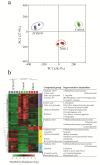Effects of Sulfur Assimilation in Pseudomonas fluorescens SS101 on Growth, Defense, and Metabolome of Different Brassicaceae
- PMID: 34827700
- PMCID: PMC8615669
- DOI: 10.3390/biom11111704
Effects of Sulfur Assimilation in Pseudomonas fluorescens SS101 on Growth, Defense, and Metabolome of Different Brassicaceae
Abstract
Genome-wide analysis of plant-growth-promoting Pseudomonas fluorescens strain SS101 (PfSS101) followed by site-directed mutagenesis previously suggested that sulfur assimilation may play an important role in growth promotion and induced systemic resistance in Arabidopsis. Here, we investigated the effects of sulfur metabolism in PfSS101 on growth, defense, and shoot metabolomes of Arabidopsis and the Brassica crop, Broccoli. Root tips of seedlings of Arabidopsis and two Broccoli cultivars were treated with PfSS101 or with a mutant disrupted in the adenylsulfate reductase cysH, a key gene in cysteine and methionine biosynthesis. Phenotyping of plants treated with wild-type PfSS101 or its cysH mutant revealed that sulfur assimilation in PfSS101 was associated with enhanced growth of Arabidopsis but with a reduction in shoot biomass of two Broccoli cultivars. Untargeted metabolomics revealed that cysH-mediated sulfur assimilation in PfSS101 had significant effects on shoot chemistry of Arabidopsis, in particular on chain elongation of aliphatic glucosinolates (GLSs) and on indole metabolites, including camalexin and the growth hormone indole-3-acetic acid. In Broccoli, PfSS101 sulfur assimilation significantly upregulated the relative abundance of several shoot metabolites, in particular, indolic GLSs and phenylpropanoids. These metabolome changes in Broccoli plants coincided with PfSS101-mediated suppression of leaf infections by Xanthomonas campestris. Our study showed the metabolic interconnectedness of plants and their root-associated microbiota.
Keywords: Pseudomonas fluorescens; flavonoids; glucosinolates (GLSs); induced systemic resistance; plant growth promotion; plant metabolomics.
Conflict of interest statement
The authors declare no conflict of interest.
Figures




References
-
- Vessey J.K. Plant growth promoting rhizobacteria as biofertilizers. Plant Soil. 2003;255:571–586. doi: 10.1023/A:1026037216893. - DOI
-
- Cheng X., Etalo D.W., van de Mortel J.E., Dekkers E., Nguyen L., Medema M.H., Raaijmakers J.M. Genome-wide analysis of bacterial determinants of plant growth promotion and induced systemic resistance byPseudomonas fluorescens. Environ. Microbiol. 2017;19:4638–4656. doi: 10.1111/1462-2920.13927. - DOI - PubMed
-
- Meldau D.G., Meldau S., Hoang L.H., Underberg S., Wunsche H., Baldwin I.T. Dimethyl Disulfide Produced by the Naturally Associated Bacterium Bacillus sp B55 Promotes Nicotiana attenuata Growth by Enhancing Sulfur Nutrition. Plant Cell. 2013;25:2731–2747. doi: 10.1105/tpc.113.114744. - DOI - PMC - PubMed
MeSH terms
Substances
LinkOut - more resources
Full Text Sources

